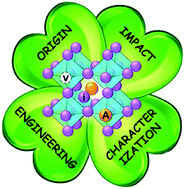当前位置:
X-MOL 学术
›
Chem. Soc. Rev.
›
论文详情
Our official English website, www.x-mol.net, welcomes your
feedback! (Note: you will need to create a separate account there.)
Defects in metal triiodide perovskite materials towards high-performance solar cells: origin, impact, characterization, and engineering
Chemical Society Reviews ( IF 40.4 ) Pub Date : 2018-04-23 00:00:00 , DOI: 10.1039/c7cs00868f Chenxin Ran 1, 2, 3, 4, 5 , Jiantie Xu 6, 7, 8, 9, 10 , Weiyin Gao 1, 2, 3, 4, 5 , Chunmao Huang 6, 7, 8, 9, 10 , Shixue Dou 11, 12, 13, 14
Chemical Society Reviews ( IF 40.4 ) Pub Date : 2018-04-23 00:00:00 , DOI: 10.1039/c7cs00868f Chenxin Ran 1, 2, 3, 4, 5 , Jiantie Xu 6, 7, 8, 9, 10 , Weiyin Gao 1, 2, 3, 4, 5 , Chunmao Huang 6, 7, 8, 9, 10 , Shixue Dou 11, 12, 13, 14
Affiliation

|
The rapid development of solar cells (SCs) based on organic–inorganic hybrid metal triiodide perovskite (MTP) materials holds great promise for next-generation photovoltaic devices. The demonstrated power conversion efficiency of the SCs based on MTP (PSCs for short) has reached over 20%. An MTP material is a kind of soft ionic solid semiconductor. The intrinsic optoelectronic properties of MTP are greatly determined by several factors, such as the crystalline phase, doping type, impurities, elemental composition, and defects in its crystal structure. In the development of PSCs, a good understanding and smart engineering of the defects in MTP have been demonstrated to be a key factor for the fabrication of high-efficiency PSCs. In this review, we start with a brief introduction to the types of defects and the mechanisms for their formation in MTP. Then, the positive and negative impacts of defects on the important optoelectronic features of MTP are presented. The optoelectronic properties mainly include charge recombination, charge transport, ion migration, and structural stability. Moreover, commonly used techniques for the characterization of the defects in MTP are systematically summarized. Recent progress on the state-of-the-art defect engineering approaches for the optimization of PSC devices is also summarized, and we also provide some perspectives on the development of high-efficiency PSCs with long-term stability through the optimization of the defects in MTP.
中文翻译:

金属三碘化物钙钛矿材料对高性能太阳能电池的缺陷:起源,影响,表征和工程设计
基于有机-无机混合金属三碘化物钙钛矿(MTP)材料的太阳能电池(SC)的快速发展为下一代光伏设备提供了广阔的前景。事实证明,基于MTP(简称PSC)的SC的功率转换效率已超过20%。MTP材料是一种软离子固体半导体。MTP的固有光电性能由几个因素决定,例如晶相,掺杂类型,杂质,元素组成以及其晶体结构中的缺陷。在PSC的开发中,已证明对MTP中的缺陷有充分的了解和精明的设计是制造高效PSC的关键因素。在本文中,我们首先简要介绍了缺陷的类型及其在MTP中形成的机理。然后,提出了缺陷对MTP重要光电特性的正负影响。光电性能主要包括电荷复合,电荷传输,离子迁移和结构稳定性。此外,系统地总结了表征MTP中缺陷的常用技术。还总结了用于PSC器件优化的最新缺陷工程方法的最新进展,并且我们还通过优化PSC器件中的缺陷为具有长期稳定性的高效PSC的开发提供了一些见解。 MTP。和结构稳定性。此外,系统地总结了表征MTP中缺陷的常用技术。还总结了用于PSC器件优化的最新缺陷工程方法的最新进展,并且我们还通过优化PSC器件中的缺陷为具有长期稳定性的高效PSC的开发提供了一些见解。 MTP。和结构稳定性。此外,系统地总结了表征MTP中缺陷的常用技术。还总结了用于PSC器件优化的最新缺陷工程方法的最新进展,并且我们还通过优化PSC器件中的缺陷为具有长期稳定性的高效PSC的开发提供了一些见解。 MTP。
更新日期:2018-04-23
中文翻译:

金属三碘化物钙钛矿材料对高性能太阳能电池的缺陷:起源,影响,表征和工程设计
基于有机-无机混合金属三碘化物钙钛矿(MTP)材料的太阳能电池(SC)的快速发展为下一代光伏设备提供了广阔的前景。事实证明,基于MTP(简称PSC)的SC的功率转换效率已超过20%。MTP材料是一种软离子固体半导体。MTP的固有光电性能由几个因素决定,例如晶相,掺杂类型,杂质,元素组成以及其晶体结构中的缺陷。在PSC的开发中,已证明对MTP中的缺陷有充分的了解和精明的设计是制造高效PSC的关键因素。在本文中,我们首先简要介绍了缺陷的类型及其在MTP中形成的机理。然后,提出了缺陷对MTP重要光电特性的正负影响。光电性能主要包括电荷复合,电荷传输,离子迁移和结构稳定性。此外,系统地总结了表征MTP中缺陷的常用技术。还总结了用于PSC器件优化的最新缺陷工程方法的最新进展,并且我们还通过优化PSC器件中的缺陷为具有长期稳定性的高效PSC的开发提供了一些见解。 MTP。和结构稳定性。此外,系统地总结了表征MTP中缺陷的常用技术。还总结了用于PSC器件优化的最新缺陷工程方法的最新进展,并且我们还通过优化PSC器件中的缺陷为具有长期稳定性的高效PSC的开发提供了一些见解。 MTP。和结构稳定性。此外,系统地总结了表征MTP中缺陷的常用技术。还总结了用于PSC器件优化的最新缺陷工程方法的最新进展,并且我们还通过优化PSC器件中的缺陷为具有长期稳定性的高效PSC的开发提供了一些见解。 MTP。











































 京公网安备 11010802027423号
京公网安备 11010802027423号